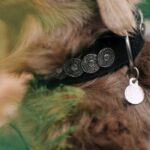When your dog has hearing problems, it might be hard to rely on verbal cues. They cannot hear your commands and the tone of your voice, so you may need additional help.
E-collar is a product that can help you – especially if you plan to train your pup. While you will still need to establish other cues and routines, it can serve as an additional signal. It comes in different types, from vibrations to sprays, so you can find one that will fit your pup.
Table of Contents
The E-collar Training Process for Deaf Dogs
Some may think that putting the e-collar on your dog is enough to train them, especially if you plan to use it as a bark collar. However, that is very far from what you should do. While training pets vary from owner to owner, it helps if you have a solid plan in hand.
When it comes to using e-collar training for your deaf dog, there are three main steps. These are identifying the main goal of your training, introducing the collar to your pup, and using it properly and effectively.
1. Determine which behavior you want to train.
Many people may overlook the first phase, but it is very important. Before buying any e-collar, decide what you will use it for.
Is it to stop random habits such as barking, or do you want to use it to let your dog learn new commands? With a clear goal, you can find the right e-collar type for your pup.
2. Introduce the collar to your dog.
Once you have your e-collar, the next thing you should do is to let your dog familiarize themselves with it. Before putting it on, let your dog smell the collar first.
Once you put it on, don’t immediately turn the e-collar on. Instead, let your dog wear it like a regular collar for at least half a day so they won’t get surprised by its effects.
3. Train your dog – and make the most of your e-collar.
Lastly, integrate the collar with your training. Also, make sure you make the most out of its available settings and controls.
Whether you use shocks, vibrations, or sprays, you should use them in moderation and safe amounts. This way, your dog will not only learn properly, but they’ll also be able to stay safe and healthy.
Types of E-collars You Can Use on Your Dog
Whether you want to find a bark collar or a general training collar, you will see many options in the market. Since training pets is a priority for many pet owners, there are a lot of products catered to it. If you are interested in purchasing one, there are a few types you should keep an eye out for.
Vibration Collar
The vibration collar is one of the most famous e-collars in the market. It is effective for most dogs, including deaf pets. As its name suggests, it uses vibrations to signal your pup.
Since it vibrates, you can use it as a cue while training your dog. This can be a helpful tool – especially since the vibrations will surely get your pup’s attention.
Spray Collar
The spray collar is another type of e-collar useful for dog training. It sends out sprays as signals, usually coming in citrusy scents. While it is not the most effective in acting as additional cues, it can help warn your dog against bad behavior.
4 Things to Do for a Successful E-collar Training
If you want your e-collar training to be successful, you should keep a few things in mind. These activities vary from creating a routine to adding positive reinforcement. By taking notes of these, you can create a more effective and comfortable experience for your pup.
1. Familiarize your dog with the e-collar first.
No matter what kind of e-collar you have, you must introduce it to your pet first. Give your dog some time with the collar – and let it act like a regular collar for at least the first day. This way, your pup wouldn’t feel surprised or uncomfortable.
2. Make sure you have the proper cues.
Before using the e-collar, you need to establish cues with your pets. Otherwise, they may get confused about why their collar is vibrating or spraying.
Since you are training with a deaf dog, using words and tones will not work. Instead, try to use facial expressions, hand gestures, and other visual cues for your dog training.
3. Create a routine.
Training your dog is not an overnight job. When training your dog, quantity is just as essential as quality. If you truly want your dog to succeed in their training, it’s vital to do it regularly.
4. Combine it with treats and pets.
Regular dogs already encounter many cues – and deaf pets have even more. It can be draining for them, especially at the start. Give your pup treats and pets after every successful training so they can see it as a positive experience.
Benefits of E-collar Training for Dogs With Hearing Problems
When training your deaf pup, it helps to have an additional device at hand. With e-collar, you can bring reinforcement through sprays or vibrations. Combine this with the occasional rewards, and you will see a vast improvement when training your dogs.
In particular, there are many benefits you can enjoy with an e-collar, such as:
- Additional cues for training
- Excellent compatibility with many dog breeds and sizes
- More control over your pup’s behaviors – especially if your collar comes with multiple settings
- Safe and effective methods as long as you use them properly
While you may want to spoil your pup, training them can go a long way. If you own one with hearing problems, e-collars are harmless yet effective training tools.




![Best Dog Breeds in India for Home [2022] Dachshund Price in India](https://petsyfy.com/wp-content/uploads/2022/07/Dachshund-Price-in-India-150x150.jpeg)

